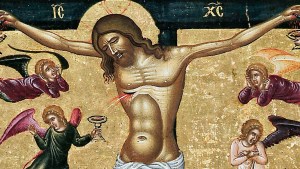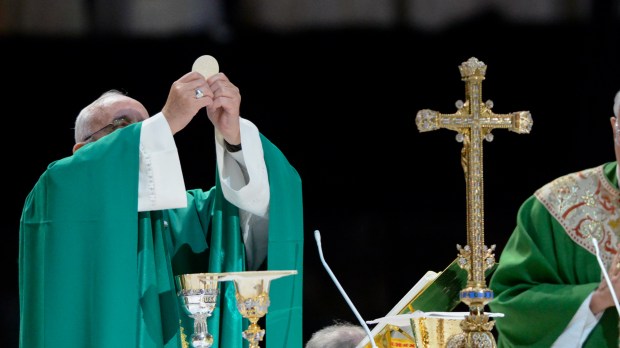Cardiologist and researcher Franco Serafini, author of the book: Un cardiologo visita Gesú (A cardiologist visits Jesus, ESD, 2018, Bologna), has studied the case of reported Eucharistic miracles in the Argentine capital, which occurred in various years (1992, 1994, 1996) and which had as a prudent custodian the then auxiliary bishop of the Argentine capital, the Jesuit who would become Cardinal Jorge Mario Bergoglio, later Pope Francis.
The future pope asked for a scientific evaluation before the Church could issue a pronouncement on the veracity of the signs indicating Eucharistic miracles in Buenos Aires.
“Eucharistic miracles are a strange kind of miracle: they are surely of help to the faithful of all times, inevitably tested by the difficult understanding of the overwhelming truth that the Son of God is present in a particle of bread and his blood in wine,” Dr. Serafini told us during the launch of a documentary on the subject produced by the Vatican on October 30, 2018.
The protocol for handling of fragments of consecrated hosts
In relation to the events in Buenos Aires, the expert recalls as a premise the protocol that a priest should follow when dealing with a consecrated fragment that accidentally or by profanation falls to the ground or gets dirty, and cannot be consumed.
John XXIII in 1962 approved in the revision of the Roman Missal that the host be placed in a chalice filled with water, so that the species may be “dissolved and that the water be poured into the sacrarium” (a sort of sink with a drain leading straight into the earth, not into any other plumbing or drainage).
The list of norms (De Defectibus) is ancient and regulates even highly unusual scenarios, like the death of the celebrant during the celebration of the Mass. The Apostolic See also describes the way in which fragments of the hosts are handled: they continue to be consecrated, and must be safeguarded.
In other words, water dissolves the species of unleavened bread from the host; if the material properties of unleavened bread are lacking, then the Substance of the Body of Christ becomes absent as well, and only then can the water be thrown away.
Before the 1962 missal, the fragments were kept in the Tabernacle until they decomposed and were taken to the sacrarium.
This is the context in which, between 1992 and 1996, prodigious Eucharistic events took place in the same parish of Buenos Aires: St. Mary’s, at 286 La Plata Avenue.
The Miracle of 1992
After the Mass on May 1, 1992, in the evening, Carlos Dominguez, a layman and extraordinary minister of Holy Communion, went to reserve the Blessed Sacrament and found two pieces of host on the corporal (the linen cloth placed under vessels holding the Eucharist) in the Tabernacle, in the shape of a half moon.
The parish priest, Fr. Juan Salvador Carlomagno, thought that they were fragments that were not fresh, and applied the above-mentioned procedure, arranging to put the pieces of the host in water.
On May 8, Father Juan checked the container, and saw that three blood clots had formed in the water, and on the walls of the tabernacle there were blood trails, almost appearing to be the product of an explosion of the host itself, describes Serafini.
Bergoglio was not yet on the scene; he returned to Buenos Aires in 1992 from his time of several years in Cordoba, called upon by Cardinal Antonio Quarracino. The auxiliary bishop at the time, Eduardo Mirás, asked for an expert opinion to determine whether or not what was found was truly human blood.
For the priests of the parish, it was a tumultuous time, but they didn’t speak of the fact publicly because they were waiting for the official response of the ecclesiastical authority.
Fr. Eduardo Perez Del Lago described the appearance of blood as being almost like the color of liver meat, but of an intense red color, without any bad smell due to decomposition.
When the water eventually evaporated, a red crust a couple of centimeters thick remained.
Miracle of 1994
Two years later, on Sunday, July 24, 1994, during the morning Mass for children, when the lay extraordinary minister of Holy Communion uncovered the ciborium, he saw a drop of blood running down the inside of the ciborium.
Serafini believes that, although the episode did not have much relevance in the narration of the other inexplicable events at that same place, it must have been an “indelible memory” to see those fresh, living drops.
Miracle of 1996
On Sunday, August 18, 1996, at the evening Mass (7:00 p.m. local time), at the end of the distribution of Communion, a member of the faithful approached the priest, Fr. Alejandro Pezet. She had noticed a host hidden at the base of a candlestick in front of the Crucifix.
The priest picked up the host with the required care; someone had probably left it there with the intention of returning for it later for some profane purpose, explains Serafini. The priest asked Emma Fernandez, 77 years old, another extraordinary minister of Holy Communion, to put it in water and to close it in the tabernacle.
Some days later, on August 26, Fernandez opened the tabernacle—she was the only one besides Fr. Pezet to have the keys—and was surprised: Inside the glass container, she could see that the host had transformed into something red, similar to a piece of meat.
Here, one of the four auxiliary bishops of Buenos Aires, Jorge Mario Bergoglio, entered the scene and asked to collect the evidence and photograph everything. The unfolding of the events was duly documented, and also communicated to the Holy See.
Preliminary scientific evidence
Medical tests were performed, involving an oncologist and a hematologist. Dr. Botto, examining the substance under a microscope, saw muscle cells, as well as living fibrous tissue. Dr. Sasot reported that the 1992 sample showed a macroscopic evolution of the material that took the form of a clot. She concluded that the sample is human blood.
However, the research had yet to give better results using adequate means and resources.
Ricardo Castañón Gómez, being a non-believer, was called upon in 1999 by the now archbishop of Buenos Aires, then Jorge Mario Bergoglio (named to the post in February 1998) to investigate that evidence. On September 28, Archbishop Bergoglio approved the proposed research protocol.
Castañon Gómez is a clinical psychologist, an expert in biochemistry and neuro-psychophysiology, who did his university studies in Germany, France, the United States and Italy.
The expert hired by Beroglio took the samples on October 5, 1999, in front of witnesses and cameras. The research was not completed until 2006.
The samples were sent by the Treasurer to Forensic Analytical in San Francisco, California. The 1992 sample was being studied for DNA; in the 1996 sample, the hypothesis was made that it would reveal DNA of non-human origin.
Surprising conclusions of science
Serafini provides an exhaustive description of the team of scientists who studied the samples: from Dr. Robert Lawrence of Delta Pathology Associates in Stockton, California, and Dr. Peter Ellis of Syney University Australia, to the now elderly Lanciano miracle scholar in Italy, Professor Linoli Arezzo.
Subsequently, the opinion of a prestigious and definitive team was requested. The team was lead by Dr. Frederick Zugibe, primary care physician and cardiologist in Rockland County, New York.
Dr. Zugibe studied the samples without knowing the origin of the material; the Australian scientists did not want to influence his expert opinion. Dr. Zugibe had been performing autopsies for over 30 years, an expert in analyzing the heart, in particular.
“This sample was alive, at the time it was collected,” said Zugibe. It’s incredible that it would have been preserved for so long, explains Serafini.
Then, in his conclusive opinion of March 2005, Dr. Zugibe specified that the substance consisted in human blood, which contained intact white blood cells, and “living” heart muscle, from the left ventricular myocardium.
Living and injured heart tissue
He declared that the tissue alterations are compatible with a recent myocardial infarction, by the obstruction of a coronary artery followed by a thrombosis or by a severe trauma to the chest in the region above the heart. Thus, it was living and wounded heart tissue.
On March 17, 2006, Dr. Castañon officially presented the evidence to Jorge Mario Bergoglio, already appointed cardinal (2001) and (since 1998) archbishop of Buenos Aires.
According to Fr. Eduardo Pérez Dal Lago, Bergoglio was expected to publicly announce the presence of Christ’s Body. Instead, to his disappointment, the archbishop limited himself to authorizing adoration in the chapel in the Church of Santa Maria, and (already since 2002), periodic exposition.
Serafini feels it is unthinkable that these gifts from heaven are so little known by the faithful of the world. He even considers almost excessive the prudence of the then-Cardinal Bergoglio regarding these miracles, verified by science.
Bergoglio in Eucharistic Adoration
Serafini, who has been in Buenos Aires, also tells of witnesses who saw Bergoglio go every year to the Parish of Santa Maria, and kneel for an hour to do Eucharistic adoration. The parish published a postcard with the photo.
When the pope was shown the photo that portrayed him from behind he said, “This is the best photo I have ever seen of a bishop: It represents him as he should be,” according to Serafini.
So far, the case is called a Eucharistic “sign” and not a miracle. The Host remains exposed on the altar on the left side of St. Mary’s Parish in Buenos Aires, in a chapel dedicated to Eucharistic adoration.
Serafini says that the Eucharistic sign in St. Mary’s Parish in Buenos Aires is treated with discretion and does not bring the clamor of major media outlets.
Pope Francis has on more than one occasion revealed that evangelization is an encounter: an encounter with the One who has given his life for humanity and who calls His disciples friends. In His words, “Love one another as I have loved you. There is no greater love than to give one’s life for one’s friends.” And Jesus, in the Body and Blood of His sacrifice, reminds humanity of His friendship.
~
This article was first published in Aleteia’s Spanish edition.

Read more:
A doctor on why “blood and water” gushed from Jesus’ heart

